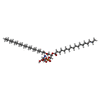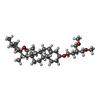登録情報 データベース : EMDB / ID : EMD-32372タイトル Cryo-EM structure of human Nav1.7(E406K) in complex with auxiliary beta subunits, huwentoxin-IV and saxitoxin (S6IV alpha helix conformer) 複合体 : human Nav1.7 in complex with beta1, beta2 and Huwentoxinタンパク質・ペプチド : Sodium channel protein type 9 subunit alphaタンパク質・ペプチド : Sodium channel subunit beta-1タンパク質・ペプチド : Sodium channel subunit beta-2リガンド : [(3aS,4R,10aS)-2,6-diamino-10,10-dihydroxy-3a,4,9,10-tetrahydro-3H,8H-pyrrolo[1,2-c]purin-4-yl]methyl carbamateリガンド : 2-acetamido-2-deoxy-beta-D-glucopyranoseリガンド : O-[(R)-{[(2R)-2,3-bis(octadecanoyloxy)propyl]oxy}(hydroxy)phosphoryl]-L-serineリガンド : CHOLESTEROL HEMISUCCINATEリガンド : (3beta,14beta,17beta,25R)-3-[4-methoxy-3-(methoxymethyl)butoxy]spirost-5-enリガンド : 1-O-OCTADECYL-SN-GLYCERO-3-PHOSPHOCHOLINEリガンド : 1,2-DIOLEOYL-SN-GLYCERO-3-PHOSPHOCHOLINE / 機能・相同性 分子機能 ドメイン・相同性 構成要素
/ / / / / / / / / / / / / / / / / / / / / / / / / / / / / / / / / / / / / / / / / / / / / / / / / / / / / / / / / / / / / / / / / / / / / / / / / / / / / / / / / / / / / / / / / / / / / / / / 生物種 Homo sapiens (ヒト)手法 / / 解像度 : 3.0 Å Yan N / Huang G / Liu D / Wei P 資金援助 Organization Grant number 国 Ministry of Science and Technology (MoST, China)
ジャーナル : Cell Rep / 年 : 2022タイトル : High-resolution structures of human Na1.7 reveal gating modulation through α-π helical transition of S6.著者 : Gaoxingyu Huang / Dongliang Liu / Weipeng Wang / Qiurong Wu / Jiaofeng Chen / Xiaojing Pan / Huaizong Shen / Nieng Yan / 要旨 : Na1.7 represents a preeminent target for next-generation analgesics for its critical role in pain sensation. Here we report a 2.2-Å resolution cryo-EM structure of wild-type (WT) Na1.7 complexed ... Na1.7 represents a preeminent target for next-generation analgesics for its critical role in pain sensation. Here we report a 2.2-Å resolution cryo-EM structure of wild-type (WT) Na1.7 complexed with the β1 and β2 subunits that reveals several previously indiscernible cytosolic segments. Reprocessing of the cryo-EM data for our reported structures of Na1.7(E406K) bound to various toxins identifies two distinct conformations of S6, one composed of α helical turns only and the other containing a π helical turn in the middle. The structure of ligand-free Na1.7(E406K), determined at 3.5-Å resolution, is identical to the WT channel, confirming that binding of Huwentoxin IV or Protoxin II to VSD allosterically induces the α → π transition of S6. The local secondary structural shift leads to contraction of the intracellular gate, closure of the fenestration on the interface of repeats I and IV, and rearrangement of the binding site for the fast inactivation motif. 履歴 登録 2021年12月10日 - ヘッダ(付随情報) 公開 2022年5月25日 - マップ公開 2022年5月25日 - 更新 2024年10月30日 - 現状 2024年10月30日 処理サイト : PDBj / 状態 : 公開
すべて表示 表示を減らす
 データを開く
データを開く 基本情報
基本情報
 マップデータ
マップデータ 試料
試料 キーワード
キーワード 機能・相同性情報
機能・相同性情報 Homo sapiens (ヒト)
Homo sapiens (ヒト) データ登録者
データ登録者 中国, 1件
中国, 1件  引用
引用 ジャーナル: Cell Rep / 年: 2022
ジャーナル: Cell Rep / 年: 2022
 構造の表示
構造の表示 ダウンロードとリンク
ダウンロードとリンク emd_32372.map.gz
emd_32372.map.gz EMDBマップデータ形式
EMDBマップデータ形式 emd-32372-v30.xml
emd-32372-v30.xml emd-32372.xml
emd-32372.xml EMDBヘッダ
EMDBヘッダ emd_32372.png
emd_32372.png emd-32372.cif.gz
emd-32372.cif.gz http://ftp.pdbj.org/pub/emdb/structures/EMD-32372
http://ftp.pdbj.org/pub/emdb/structures/EMD-32372 ftp://ftp.pdbj.org/pub/emdb/structures/EMD-32372
ftp://ftp.pdbj.org/pub/emdb/structures/EMD-32372 emd_32372_validation.pdf.gz
emd_32372_validation.pdf.gz EMDB検証レポート
EMDB検証レポート emd_32372_full_validation.pdf.gz
emd_32372_full_validation.pdf.gz emd_32372_validation.xml.gz
emd_32372_validation.xml.gz emd_32372_validation.cif.gz
emd_32372_validation.cif.gz https://ftp.pdbj.org/pub/emdb/validation_reports/EMD-32372
https://ftp.pdbj.org/pub/emdb/validation_reports/EMD-32372 ftp://ftp.pdbj.org/pub/emdb/validation_reports/EMD-32372
ftp://ftp.pdbj.org/pub/emdb/validation_reports/EMD-32372 リンク
リンク EMDB (EBI/PDBe) /
EMDB (EBI/PDBe) /  EMDataResource
EMDataResource マップ
マップ ダウンロード / ファイル: emd_32372.map.gz / 形式: CCP4 / 大きさ: 52.7 MB / タイプ: IMAGE STORED AS FLOATING POINT NUMBER (4 BYTES)
ダウンロード / ファイル: emd_32372.map.gz / 形式: CCP4 / 大きさ: 52.7 MB / タイプ: IMAGE STORED AS FLOATING POINT NUMBER (4 BYTES) 試料の構成要素
試料の構成要素 解析
解析 試料調製
試料調製 電子顕微鏡法
電子顕微鏡法 FIELD EMISSION GUN
FIELD EMISSION GUN
 画像解析
画像解析 ムービー
ムービー コントローラー
コントローラー



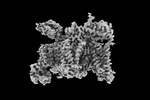
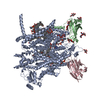




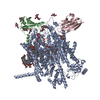
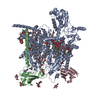







 Z (Sec.)
Z (Sec.) Y (Row.)
Y (Row.) X (Col.)
X (Col.)






















